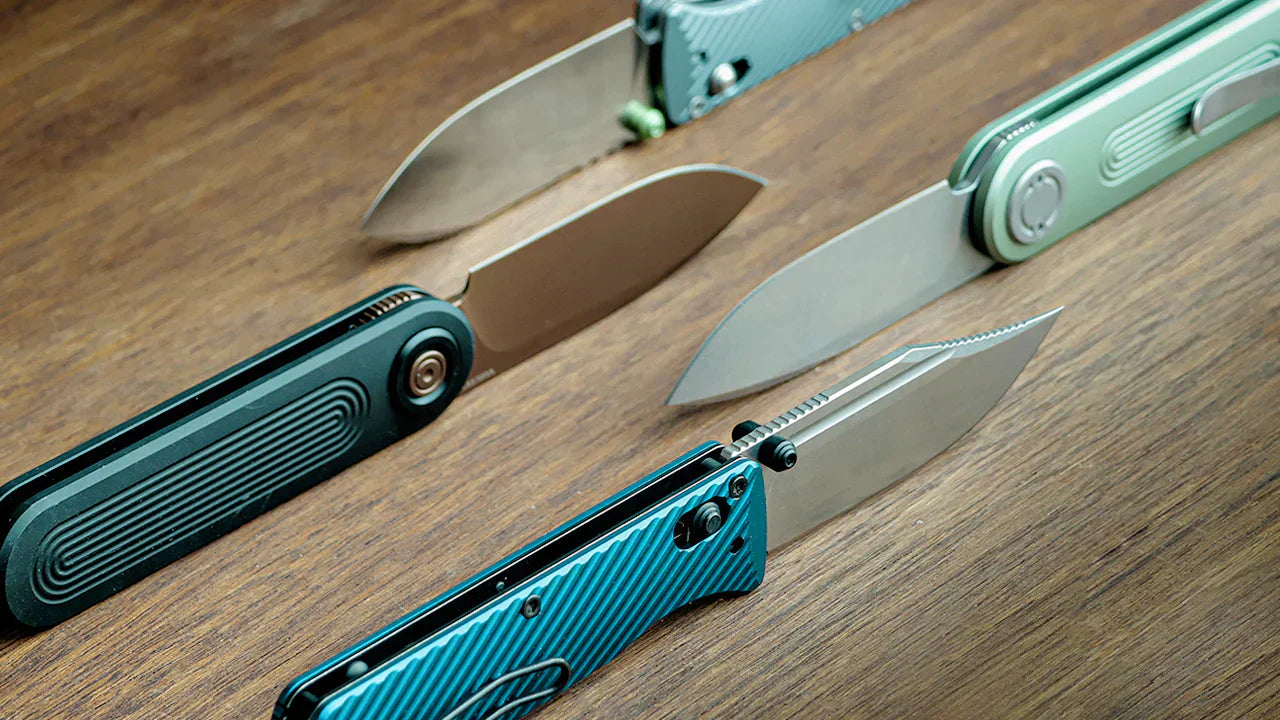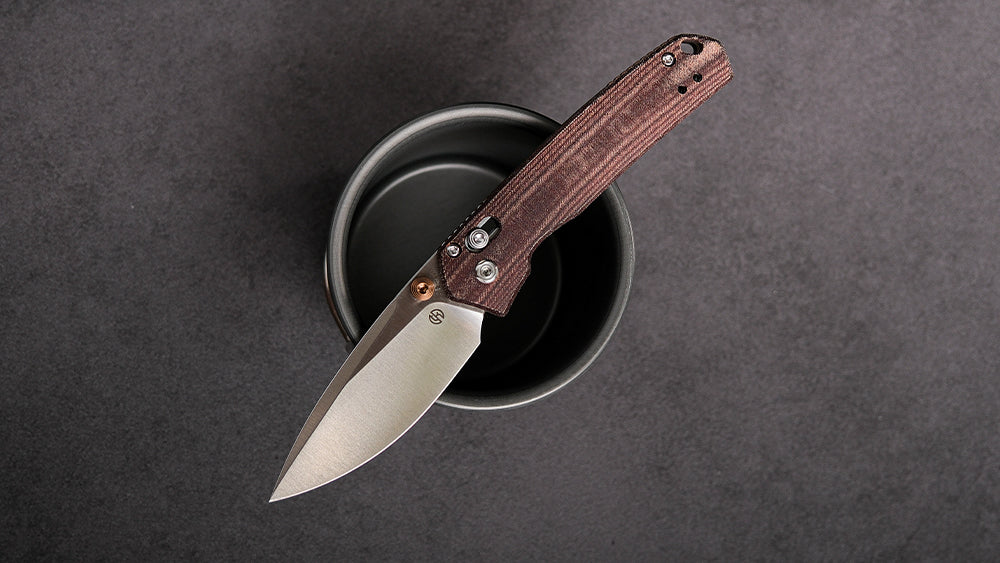When selecting mid-tier stainless steel for EDC knives, two popular options are N690 and 154CM, both known for their high-carbon chromium compositions. They’re both solid EDC knife steel options, widely used in folding knives, fixed blades, and outdoor tools.
These steels are often compared to 440C (154cm was developed as an upgraded version of 440C), but there are some key compositional differences that set them apart.
Composition and Corrosion Resistance
When comparing N690 vs 154CM corrosion resistance, the former one clearly performs better due to its cobalt addition and higher chromium content.
Significantly, N690 features an addition of 1.5% cobalt, while 154CM does not contain any of it. This addition enhances the tempering resistance and secondary hardening capability of N690 compared to 154CM.

In terms of corrosion resistance, N690 has a chromium content of 17.3%, while 154CM has a lower chromium content of 14%. This makes N690 steel more suitable for kitchen knives and tools that require maximum corrosion resistance.
About 11.79% of the chromium in Böhler N690 remains in solution to combat corrosion, while only about 9.5% of the chromium remains in solution in 154CM, with the remainder used to form carbides. Therefore, the excellent corrosion resistance of N690 makes it a better choice for kitchen knives, as food acids can cause kitchen knives to stain and rust.
Compared to 154CM stainless steel, N690 is a more reliable knife steel with high chromium, and can maintain a cleaner, more stain-free surface.
Toughness
Toughness refers to a knife's ability to resist chipping, cracking, or breaking under impact or use.
When comparing the toughness of N690 and 154CM steels, there is no clear winner; both exhibit similar levels of toughness, comparable to D2 steel, but slightly lower than VG10 steel.
Both 154CM and N690 have a carbon content of about 1%, leading to a significant amount of carbide formation. The higher volume fraction of carbides in 154CM contributes to its high wear resistance but also reduces its toughness.
Similarly, the high chromium content of 17.3% in N690 enhances its corrosion resistance but subsequently lowers its toughness.
The addition of 1.5% cobalt in N690 also negatively affects toughness. Therefore, while N690 has the potential for higher toughness based on its composition, the significant amounts of chromium and carbides in both steels limit their toughness.
Their toughness levels fall between 440C and VG10 stainless steels, with toughness lower than CPM 154 but better than 440C.
Hardness
The maximum hardness of N690 steel is about 62 HRC, while 154CM steel can achieve slightly higher hardness, up to 64 HRC.
154CM typically has higher hardness than N690 due to its higher carbon content in solution, approximately 0.41%, compared to N690's carbon content of 0.38%.
After proper heat treatment, 154CM's hardness is slightly higher than that of N690, allowing it to better adapt to different types of knives.

Due to the addition of small amounts of cobalt and molybdenum, Böhler N690 has a better secondary hardening response.
So for 154CM vs N690 hardness, the difference is small but consistent—154CM offers a bit more resistance to edge deformation.
Edge Retention and Wear Resistance
The edge retention and wear resistance of N690 and 154CM stainless steels are comparable.
In knives, they achieve highly similar edge retention, but 154CM can achieve higher edge retention when heat-treated to higher hardness levels.
The volume fraction of carbides in 154CM is slightly higher at 17.5%, while the volume fraction of carbides in N690 steel is 12%.
This is reflected in wear tests, where 154CM shows better wear resistance with a wear value of 49 mg, while N690 has a wear value of 55-66 mg, with lower values being better.
However, the differences are relatively small. The hardness values they can achieve are very similar, both in the 60s HRC range. Therefore, in practical knife use, both N690 and 154CM are expected to have excellent edge retention and wear resistance due to their high hardness.
The chromium carbides in both steels also provide good wear resistance.
Ease of Sharpening
N690 is easier to sharpen and grind than 154CM knives due to its lower volume fraction of hard carbides. This may be due to the lower volume fraction of chromium carbides in N690, approximately 12%, compared to 17.5% in 154CM.
The higher carbide content in 154CM makes it more difficult to wear down and remove material during grinding and sharpening. This gives N690 an advantage in setting an initial fine edge on blades quickly and easily for end users and manufacturers.
Regardless of which steel you choose, maintaining a razor-sharp edge requires proper sharpening techniques and regular maintenance to maximize your knife's performance.

Final Thoughts on N690 vs. 154CM Steel
In conclusion, both N690 and 154CM are excellent choices for knife steels, offering a balance of performance characteristics.
N690 has a slight advantage in corrosion resistance due to its higher chromium content and is easier to sharpen, making it more user-friendly for maintenance.
On the other hand, 154CM steel knife can achieve higher hardness and edge retention when heat-treated to optimal levels.
Ultimately, the choice between the two may come down to personal preference and specific use cases, as both offer strong value for anyone seeking the best stainless steel for EDC knives, without moving into ultra-premium pricing.
Note:
- Per BÖHLER, N690 is a corrosion-resistant, martensitic chromium steel with a high carbon content and the addition of cobalt, molybdenum and vanadium. BÖHLER N690 is also approved for food and beverage contact.
- Crucible Service Centers were bought by SB International in 2010 (SB Specialty Metals).
Chemical Composition
| Steel Name | C (%) | Si (%) | Mn (%) | Cr (%) | Mo (%c) | V (%) | Co (%) |
| N690 | 1.08 | 0.40 | 0.40 | 17.30 | 1.10 | 0.10 | 1.50 |
| 154CM | 1.05 | 0.30 | 0.50 | 14.00 | 4.00 | - | - |
Reference:
- https://www.bohler-edelstahl.com/en/products/n690/
- https://sb-specialty-metals.com/wp-content/uploads/2022/05/Data-Sheet-154CM-SBSM-R1.pdf





Leave a comment
All comments are moderated before being published.
This site is protected by hCaptcha and the hCaptcha Privacy Policy and Terms of Service apply.